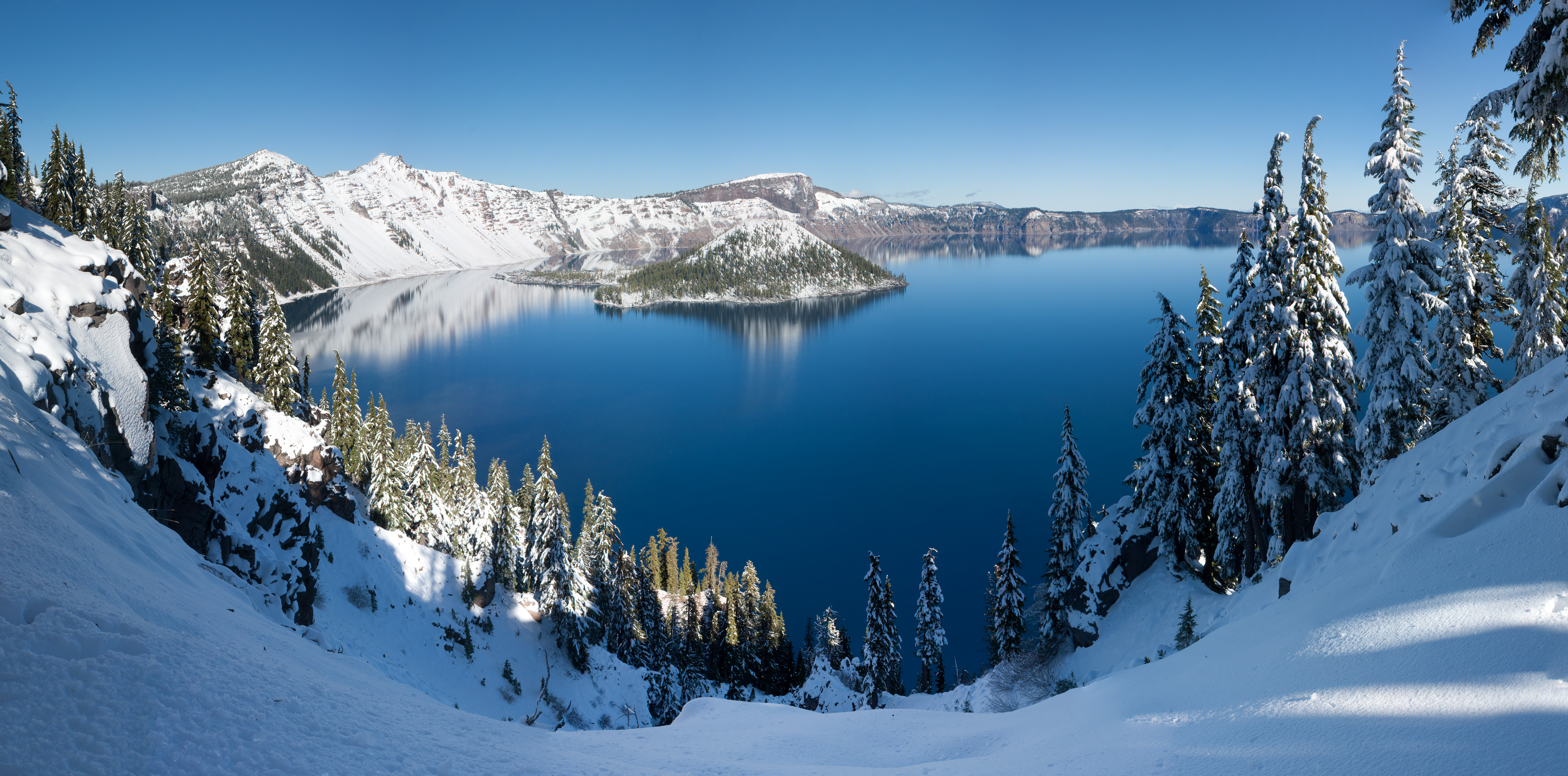
Crater Lake
Crater Lake (Klamath: Giiwas)[2] is a volcanic crater lake in south-central Oregon in the Western United States. It is the main feature of Crater Lake National Park and is famous for its deep blue color and water clarity. The lake partly fills a 2,148-foot-deep (655 m) caldera[3] that was formed around 7,700 (± 150) years ago[4] by the collapse of the volcano Mount Mazama. No rivers flow into or out of the lake; the evaporation is compensated for by rain and snowfall at a rate such that the total amount of water is replaced every 250 years. With a depth of 1,949 feet (594 m),[5] the lake is the deepest in the United States. In the world, it ranks tenth for maximum depth, as well as third for mean (average) depth.[6]
For other uses, see Crater Lake (disambiguation).Crater Lake
precipitation and snowmelt only
evaporation, subsurface seepage to Wood River
23.3 sq mi (60 km2)
United States
6 mi (9.7 km)
5 mi (8.0 km)
20.6 sq mi (53 km2)
1,148 ft (350 m)
1,949 ft (594 m)[1]
4.49 cu mi (18.7 km3)
157 years
21.8 mi (35.1 km)
6,178 ft (1,883 m)
Crater Lake features two small islands. Wizard Island, located near the western shore of the lake, is a cinder cone about 316 acres (128 ha) in size. Phantom Ship, a natural rock pillar, is located near the southern shore.
Since 2002, one of Oregon's regular-issue license-plate designs has featured Crater Lake[7] and a one-time plate surcharge is used to support the operation of Crater Lake National Park.[8] The commemorative Oregon State Quarter, which was released by the United States Mint in 2005, features an image of Crater Lake on its reverse.[9]
The lake and surrounding park areas offer many recreational activities, including hiking, biking, snowshoeing, fishing, and cross-country skiing, and during the summer, campgrounds and lodges at Crater Lake are open to visitors.
Dimensions and depth[edit]
The lake is 5 by 6 miles (8.0 by 9.7 km) across, with a caldera rim ranging in elevation from 7,000 to 8,000 feet (2,100 to 2,400 m) and an average lake depth of 1,148 feet (350 m). The lake's maximum depth has been measured at 1,949 feet (594 m),[3][5][15][16] which fluctuates slightly as the weather changes.[3] On the basis of maximum depth, Crater Lake is the deepest lake in the United States, the second-deepest in North America (after Great Slave Lake in Canada), and the ninth-deepest lake in the world.[17] Crater Lake is often cited as the seventh-deepest lake in the world, but this ranking excludes Lake Vostok in Antarctica,[18][19] which is beneath about 13,000 feet (4,000 m) of ice, and the recent depth soundings of O'Higgins/San Martín Lake, which is along the border of Chile and Argentina.[20]
When considering the mean, or average depth of lakes, Crater Lake becomes the deepest lake in the Western Hemisphere and the third-deepest in the world. Crater Lake Institute Director and limnologist Owen Hoffman states that "Crater Lake is the deepest, when compared on the basis of average depth among lakes whose basins are entirely above sea level. The average depths of Lakes Baikal and Tanganyika are deeper than Crater Lake; however, both have basins that extend below sea level."[19][21]
Recreation[edit]
Located 56 miles (90 km) north of the city of Klamath Falls and 62 miles (100 km) northeast of Medford, Crater Lake can be reached from U.S. Route 97 on the east, on the southwest by Highway 62, and on the northwest by Highway 138.[41] Crater Lake and the remnants of Mount Mazama can be seen from Rim Drive, a 33-mile (53 km) road that surrounds the caldera,[42] which is the only part within the Crater Lake National Park where vehicles are permitted.[41] The Garfield Peak Trail, which runs 1.5 miles (2.4 km) east from the Crater Lake Lodge, offers views from 1,900 feet (580 m) above the lake's surface, with Mount Shasta visible 125 miles (201 km) southward. Another trail runs for 2.5 miles (4.0 km) from Rim Drive's eastern edge to Mount Scott, which offers views of central and southern Oregon such as the Three Sisters located 80 miles (130 km) north of Mazama and Mount Thielsen, also to the north. The Cleetwood trail leads for 1 mile (1.6 km) down the northern flank of the caldera rim, eventually reaching Cleetwood Cove where boat trips run from late June or early July throughout the summer season to Wizard Island. Wizard Island can be climbed, offering views of Crater Lake.[42]
Swimming is permitted in Crater Lake, but the only legal and safe way to get to the shore is by following Cleetwood Cove trail and people can enter the water from there.[12] Other activities include fishing and a 2-hour boat tour around the lake provided by a Park Ranger from Crater Lake National Park.[43]
As the region lies within a national park area, collecting rocks within the vicinity is prohibited unless a permit is obtained.[44] The park's facilities lie at Rim Village, at the southern edge of the caldera.[41] Lodging and camping facilities open during the summer season between May and October.[45] No lodges, gas stations, or camping areas remain open from October through late May.[46] Popular activities within Crater Lake National Park include biking,[47] fishing,[48] cross-country skiing, and snowshoeing.[49]